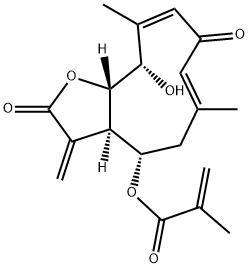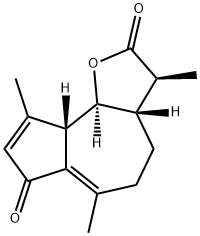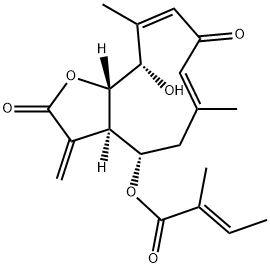2,6-Dimethyl-2,5-heptadien-4-one
- CAS NO.:504-20-1
- Empirical Formula: C9H14O
- Molecular Weight: 138.21
- MDL number: MFCD00008901
- EINECS: 207-986-3
- SAFETY DATA SHEET (SDS)
- Update Date: 2024-12-18 14:15:30

What is 2,6-Dimethyl-2,5-heptadien-4-one?
Description
2,6-Dimethyl-2,5-heptadien-4-one (DMHD4O) is an industrially important diene molecule chemically known as phorone or diisopropylidene acetone, available in the form of yellow to green liquid and yellowish green prisms. It is a self-condensation product of acetone and can also be obtained from camphor. In particular, it is used as a solvent for nitrocellulose, synthetic resins, fibers, coating compositions, stains, lubricant additives, odor-resistant agent production, and intermediate for organic and pharmaceutical synthesis[1]. This compound possesses the property of increasing the reactivity of enzymes involved in glutathione metabolism.
Chemical properties
Yellow liquid or yellow green prismatic crystal
The Uses of 2,6-Dimethyl-2,5-heptadien-4-one
Diisopropylidene Acetone is a reagent used in the preparation of biaryls by Suzuki-Miyaura cross coupling reaction.
Definition
ChEBI: Phorone is a dialkenyl ketone.
General Description
A yellowish liquid with a solvent-like odor. Density 7.3 lb / gal. Very low vapor pressure (0.38 mm Hg at 68°F). Flash point 185°F. Combustible but difficult to ignite. Used as a solvent for lacquers and coatings.
Air & Water Reactions
Slightly soluble in water.
Reactivity Profile
Ketones, such as 2,6-DIMETHYL-2,5-HEPTADIEN-4-ONE, are reactive with many acids and bases liberating heat and flammable gases (e.g., H2). The amount of heat may be sufficient to start a fire in the unreacted portion of the ketone. Ketones react with reducing agents such as hydrides, alkali metals, and nitrides to produce flammable gas (H2) and heat. Ketones are incompatible with isocyanates, aldehydes, cyanides, peroxides, and anhydrides. They react violently with aldehydes, HNO3, HNO3 + H2O2, and HClO4.
Health Hazard
Inhalation or contact with material may irritate or burn skin and eyes. Fire may produce irritating, corrosive and/or toxic gases. Vapors may cause dizziness or suffocation. Runoff from fire control or dilution water may cause pollution.
Safety Profile
Moderately toxic by subcutaneous route. Combustible when exposed to heat or flame; can react with oxidizing materials. To fight fire, use foam, CO2, dry chemical. When heated to decomposition it emits acrid smoke and irritating fumes. See also ISOPHORON
Purification Methods
Crystallise phorone repeatedly from EtOH. [Beilstein 1 IV 3564.]
References
[1] V. Arjunan. “Electronic structure simulations of 2,6-dimethyl-2,5-heptadien-4-one by FTIR, FT-Raman, NMR, UV–vis, NBO and density functional theory.” Molecular Simulation 39 1 (2013): 185–198.
Properties of 2,6-Dimethyl-2,5-heptadien-4-one
| Melting point: | 23-26 °C(lit.) |
| Boiling point: | 198-199 °C(lit.) |
| Density | 0.885 g/mL at 25 °C(lit.) |
| vapor density | 4.8 (vs air) |
| vapor pressure | 0.38 mm Hg ( 20 °C) |
| refractive index | n |
| Flash point: | 175 °F |
| storage temp. | 2-8°C |
| solubility | Chloroform (Slightly), Methanol (Slightly) |
| form | Solid |
| color | Light Yellow to Yellow Oil to Low-Melting |
| Merck | 7333 |
| InChI | InChI=1S/C9H14O/c1-7(2)5-9(10)6-8(3)4/h5-6H,1-4H3 |
| CAS DataBase Reference | 504-20-1(CAS DataBase Reference) |
| EPA Substance Registry System | Phorone (504-20-1) |
Safety information for 2,6-Dimethyl-2,5-heptadien-4-one
| Signal word | Warning |
| Pictogram(s) |
 Exclamation Mark Irritant GHS07 |
| GHS Hazard Statements |
H315:Skin corrosion/irritation H319:Serious eye damage/eye irritation H335:Specific target organ toxicity, single exposure;Respiratory tract irritation |
| Precautionary Statement Codes |
P261:Avoid breathing dust/fume/gas/mist/vapours/spray. P305+P351+P338:IF IN EYES: Rinse cautiously with water for several minutes. Remove contact lenses, if present and easy to do. Continuerinsing. |
Computed Descriptors for 2,6-Dimethyl-2,5-heptadien-4-one
| InChIKey | MTZWHHIREPJPTG-UHFFFAOYSA-N |
| SMILES | C/C(/C)=C\C(=O)/C=C(\C)/C |
New Products
Tert-butyl bis(2-chloroethyl)carbamate 4-Methylphenylacetic acid N-Boc-D-alaninol N-BOC-D/L-ALANINOL 3-Morpholino-1-(4-nitrophenyl)-5,6-dihydropyridin- 2(1H)-one Furan-2,5-Dicarboxylic Acid Tropic acid 1,1’-CARBONYLDIIMIDAZOLE DIETHYL AMINOMALONATE HYDROCHLORIDE R-2-BENZYLOXY PROPIONIC ACID 1,1’-CARBONYLDI (1,2-4 TRIAZOLE) N-METHYL INDAZOLE-3-CARBOXYLIC ACID (2-Hydroxyphenyl)acetonitrile 4-Bromopyrazole 5-BROMO-2CYANO PYRIDINE 5,6-Dimethoxyindanone 5-broMo-2-chloro-N-cyclopentylpyriMidin-4-aMine 2-(Cyanocyclohexyl)acetic acid 4-methoxy-3,5-dinitropyridine 2-aminopropyl benzoate hydrochloride 1-(4-(aminomethyl)benzyl)urea hydrochloride diethyl 2-(2-((tertbutoxycarbonyl)amino) ethyl)malonate tert-butyl 4- (ureidomethyl)benzylcarbamate Ethyl-2-chloro((4-methoxyphenyl)hydrazono)acetateRelated products of tetrahydrofuran





![(3S)-4β-Acetoxy-3,3aβ,4,5,9aβ,9bα-hexahydro-3β,6,9-trimethylazuleno[4,5-b]furan-2,7-dione](https://img.chemicalbook.in/CAS/GIF/5989-43-5.gif)


You may like
-
 2033-24-1 98%View Details
2033-24-1 98%View Details
2033-24-1 -
 1975-50-4 98%View Details
1975-50-4 98%View Details
1975-50-4 -
 2-HYDROXY BENZYL ALCOHOL 98%View Details
2-HYDROXY BENZYL ALCOHOL 98%View Details
90-01-7 -
 2-Chloro-1,3-Bis(Dimethylamino)Trimethinium Hexafluorophosphate 221615-75-4 98%View Details
2-Chloro-1,3-Bis(Dimethylamino)Trimethinium Hexafluorophosphate 221615-75-4 98%View Details
221615-75-4 -
 61397-56-6 CIS BROMO BENZOATE 98%View Details
61397-56-6 CIS BROMO BENZOATE 98%View Details
61397-56-6 -
 14714-50-2 (2-Hydroxyphenyl)acetonitrile 98+View Details
14714-50-2 (2-Hydroxyphenyl)acetonitrile 98+View Details
14714-50-2 -
 118753-70-1 98+View Details
118753-70-1 98+View Details
118753-70-1 -
 733039-20-8 5-broMo-2-chloro-N-cyclopentylpyriMidin-4-aMine 98+View Details
733039-20-8 5-broMo-2-chloro-N-cyclopentylpyriMidin-4-aMine 98+View Details
733039-20-8